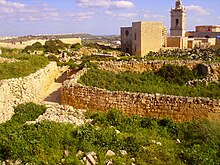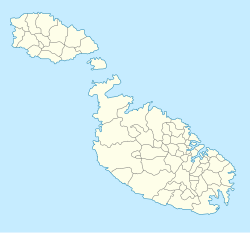Cittadella (Gozo)
| Cittadella | |
|---|---|
Iċ-Ċittadella | |
| Victoria, Gozo, Malta | |
 View of the Cittadella from the east | |
 Map of the Cittadella's fortifications | |
| Coordinates | 36°2′47″N 14°14′22″E / 36.04639°N 14.23944°E |
| Type | Citadel |
| Site information | |
| Open to the public | Yes |
| Condition | Intact |
| Site history | |
| Built | c. 1500 BC (first fortifications) 15th century – 1622 (present fortifications) |
| Built by | Crown of Aragon Order of Saint John |
| In use | c. 1500 BC – 1868 |
| Materials | Limestone |
| Battles/wars | Invasion of Gozo (1551) Capture of Gozo (1798) |
| Garrison information | |
| Past commanders | Gelatian de Sessa (attack of 1551) |
The Cittadella (Maltese: Iċ-Ċittadella), also known as the Citadel, is a small fortified city and citadel which lies in the heart of Victoria on the island of Gozo, Malta. The area has been inhabited since the Bronze Age, and in the Medieval era it was known as the Gran Castello. The Cittadella has been on Malta's tentative list of UNESCO World Heritage Sites since 1998.[1]
History

Antiquity
Archaeological remains show that the area presently occupied by the Cittadella was first inhabited during the Bronze Age. The settlement was further developed by the Phoenicians, and during the Roman era, it became the acropolis of a city known as Glauconis Civitas.
Medieval period and Hospitaller rule
During the Medieval period, the settlement was transformed into a castle, which became known as the Gran Castello. Over time, the Cittadella became too small for the growing population, and the suburb of Rabat developed around the southern part of the walled citadel. In the fifteenth century, during the rule of the Crown of Aragon, the city's fortifications were strengthened. The fortifications which surround the town mainly served to protect the village communities from foraging corsairs who raided the Maltese islands in order to take slaves.
The largest of these raids took place in July 1551, when a force of 10,000 Ottomans invaded Gozo and besieged the Cittadella. The city, which was under the control of Governor Gelatian de Sessa, capitulated after a few days of bombardment. Gozo's population of 5000 to 6000 people had taken refuge within the Cittadella, and these were all taken as slaves when the city fell. Only a monk and 40 old people, which had been spared by the invaders, and about 300 others who managed to escape by scaling down the city walls escaped slavery.
After the invasion, the damaged fortifications of the Cittadella were repaired, but were not modernized. In the late 16th century, the architects Giovanni Rinaldini and Vittorio Cassar proposed plans for the renovation of the city.[2] The entrance and southern walls were eventually completely rebuilt starting from 1599, and they turned the city from a small castle into a gunpowder fortress. In 1603 works reached an advanced state, and work was complete in 1622. On the other hand, the city's northern walls were retained in their original medieval form. Various bastions, cavaliers, batteries and polveristas were built in the city.
Gozo's population stayed within the walls of the Cittadella between dusk and dawn until this curfew was lifted on 15 April 1637. The city was the only fortified refuge against attack for the island's inhabitants until Fort Chambray was built in the 18th century.[3]
In the 17th century, the Cittadella's defences were criticized and plans were made to demolish the city in 1645. Mines were actually built under the bastions to destroy them if necessary, but the demolition was never done.[4]
French occupation and British rule
In June 1798, the Maltese islands were occupied by the French, but the Maltese revolted after a couple of months of French rule. The Gozitans rebelled on 3 September, and the French garrison withdrew to the Cittadella, until they capitulated on 28 October after some negotiations. A day later, the British transferred control of the Cittadella to the Gozitans, who set up a provisional government led by Francesco Saverio Cassar and briefly administered the island as the independent state La Nazione Gozitana.[5]
The fortifications of the Cittadella were decommissioned by the British on 1 April 1868. The Cittadella's fortifications and the ruined buildings within the city were included on the Antiquities List of 1925.[6]
Present day

The Cittadella's fortifications, including part of the medieval enceinte, are intact. The southern part of the city, where the cathedral and other buildings are located, is also in good condition, but the northern part is largely in ruins. Many of these ruins date back to the medieval period, and they contain archaeological deposits.[1]
In 2006, the first plans were made to restore the Cittadella, as part of a project that also includes the restoration of the fortifications of Valletta, Birgu and Mdina on mainland Malta.[7] Restoration began in 2008 and is ongoing.[8][9]
Throughout the course of restoration, various architectural features and archaeological remains have been unearthed, including the city's original entrance.[10][11]
Description
The Cittadella was built on a promontory overlooking the present day city of Victoria. This location was originally chosen because it is a naturally defensible hill, dominating the surrounding countryside and having views of large parts of the coastline.
Fortifications

The city's fortifications mainly date from the early 17th century, when they were rebuilt by the Order of Saint John, although some parts of the city walls date back to the 15th century. The fortifications which exist today consist of:
- Medieval enceinte – a semi-circular enceinte on the northern side of the Cittadella. It is the oldest part of the city walls, dating back to the 15th century.[12]
- St. Michael Bastion – a large arrowhead-shaped bastion located at the south of the city. It originally had an echaugette but this has been replaced by a clock tower.[13]
- St. Martin Demi-Bastion – a demi-bastion located at the west end of the city. It has an echaugette with a flat roof.[14]
- St. Martin Cavalier – a cavalier located close to St. Martin Demi-Bastion and is linked with the medieval enceinte. Some of its upper elements are missing.[2][15]
- St. John Demi-Bastion – a demi-bastion located at the east end of the city, linked with the medieval enceinte. It has an echaugette with a flat roof.[16]
- St. John Cavalier – a cavalier located close to St. John Demi-Bastion. A gunpowder magazine was later built on top of the cavalier.[17]
- Ravelin – a small triangular ravelin located near the entrance to the city. It has lost most of its stonework and has been converted into a private garden.[18]
- Low Battery – a pentagonal battery located close to St. John Demi-Bastion.[19]
Buildings

A number of notable buildings are located within the walls of the Cittadella. These include:
- Cathedral of the Assumption – a Baroque cathedral which houses the Roman Catholic Diocese of Gozo. It was built between 1697 and 1711 by Lorenzo Gafà, a Maltese architect who also built the Cathedral of Mdina. It is said that it lies on the site where a Roman temple dedicated to Juno once stood. It is most famous for the remarkable trompe l'oeil painting on its ceiling, which depicts the interior of a dome that was never built.[20]
- Chapel of St. Joseph – a chapel built in 1625 on the site of an 11th-century chapel.[20]
- Chapel of St. Barbara within the Walls – a chapel built in the early 17th century. Vittorio Cassar, son of the well known architect Girolamo Cassar, is buried there.[20]
- Courts of Justice – law courts housed in the former Governor's Palace, which was built in the early 16th century
- Old Prison – a former prison used between the 16th century and 1962, that is now open to the public as a museum.[21]
- Gozo Museum of Archaeology – a museum dedicated to Gozitan history, from the prehistoric to medieval periods.[22]
- Natural Science Museum – a museum dedicated to Gozo's geography, geology and natural science.
- Folklore Museum – a museum dedicated to Gozitan folklore housed in a cluster of early 16th century houses.[23]
References
- ^ a b "Cittadella (Victoria - Gozo)". UNESCO Tentative List. Retrieved 9 March 2014.
- ^ a b Spiteri, Stephen C. (2013). "In Defence of the Coast (I) - The Bastioned Towers". Arx - International Journal of Military Architecture and Fortification (3): 70–74. Retrieved 26 April 2015.
- ^ "History of Gozo". Gozo Tourism Association. Retrieved 6 March 2015.
- ^ "Restoration of the Cittadella". MilitaryArchitecture.com. Retrieved 6 March 2015.
- ^ Sciberras, Sandro. "Maltese History - F. The French Occupation" (PDF). St Benedict College. Retrieved 6 March 2015.
- ^ "Protection of Antiquities Regulations 21st November, 1932 Government Notice 402 of 1932, as Amended by Government Notices 127 of 1935 and 338 of 1939". Malta Environment and Planning Authority. Archived from the original on 20 April 2016.
- ^ Zammit, Ninu (12 December 2006). "Restoration of forts and fortifications". Times of Malta. Retrieved 6 March 2015.
- ^ "Ambitious Citadel restoration project". Times of Malta. 10 August 2008. Retrieved 6 March 2015.
- ^ Cocks, Joanne (10 December 2012). "Gozo's Cittadella getting €6m restoration". Times of Malta. Retrieved 6 March 2015.
- ^ Dalli, Kim (21 June 2014). "Original entrance to Gozo Citadel exposed". Times of Malta. Retrieved 6 March 2015.
- ^ Spiteri, Stephen C. (14 July 2014). "Unearthed features at the Cittadella". MilitaryArchitecture.com. Retrieved 6 March 2015.
- ^ "Medieval enceinte - Cittadella" (PDF). National Inventory of the Cultural Property of the Maltese Islands. 28 June 2013. Retrieved 13 July 2015.
- ^ "St Michael Bastion – Cittadella" (PDF). National Inventory of the Cultural Property of the Maltese Islands. 28 June 2013. Retrieved 13 July 2015.
- ^ "St Martin Demi-bastion - Cittadella" (PDF). National Inventory of the Cultural Property of the Maltese Islands. 28 June 2013. Retrieved 13 July 2015.
- ^ "St Martin Cavalier - Cittadella" (PDF). National Inventory of the Cultural Property of the Maltese Islands. 28 June 2013. Retrieved 13 July 2015.
- ^ "St John Demi-Bastion - Cittadella" (PDF). National Inventory of the Cultural Property of the Maltese Islands. 28 June 2013. Retrieved 13 July 2015.
- ^ "St John Cavalier - Cittadella" (PDF). National Inventory of the Cultural Property of the Maltese Islands. 28 June 2013. Retrieved 13 July 2015.
- ^ "Ravelin - Cittadella" (PDF). National Inventory of the Cultural Property of the Maltese Islands. 28 June 2013. Retrieved 13 July 2015.
- ^ "Low Battery - Cittadella" (PDF). National Inventory of the Cultural Property of the Maltese Islands. 28 June 2013. Retrieved 13 July 2015.
- ^ a b c Scerri, John. "Rabat (Victoria)". malta-canada.com. Retrieved 9 March 2014.
- ^ "The Old Prison". malta.com. Retrieved 6 March 2015.
- ^ "Archaeology Museum". Reach Malta. Retrieved 6 March 2015.
- ^ "Folklore Museum". Heritage Malta. Retrieved 6 March 2015.

